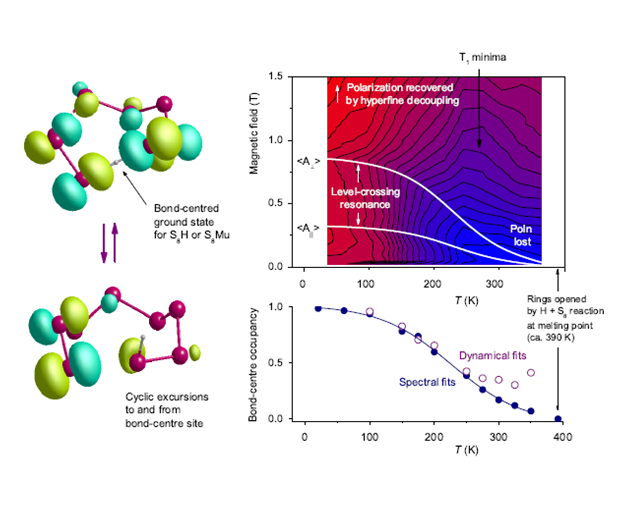For many semiconductors and dielectrics, isolated or monatomic hydrogen defects are difficult to detect by conventional spectroscopies. Present knowledge of them comes chiefly from studies of muonium, the light pseudo-isotope of hydrogen. Muonium spectroscopy first provided the much-needed atomistic picture of interstitial hydrogen in Group-IV elements. But details of the solid-state chemistry and spin dynamics of muons and protons in the Group-VI semiconductors have been slower to emerge. In J. Phys.: Condensed Matter vol. 23 (no. 21, 10 August 2011) p. 315801, the elusive monatomic hydrogen defect in solid sulphur is finally identified.
The HiFi instrument is a newly commissioned high-field muon spin resonance (µSR) spectrometer for magnetic and chemical studies at ISIS. Data from HiFi show how positive muons create paramagnetic centres in sulphur. These mimic the neutral reaction product of ion-implanted protons or interstitial atomic hydrogen, which was hitherto unknown in this element.
The implanted muons insert into the centre of a stretched S-S bond of a parent S8 ring. The bond-centre site was unanticipated, and S8H is as yet unknown to electron spin resonance spectroscopy. The structure is confirmed for orthorhombic octasulphur by supercell density-functional calculations.
The spin density of the unpaired electron is highly localized on the nearest-neighbour S atoms, accounting for the huge axial anisotropy seen in the hyperfine spectra. The ring structure of the parent S8 molecule is retained in the radical's ground state. The bond-centre site is quite symmetrical in equilibrium geometry so that this unusual hydrogen bond does not rely on vibrational bonding of the light nuclei, either for muon or proton (the muon has about one ninth the proton mass).
Towards and above room temperature, the level-crossing resonance shifts dramatically to lower and lower magnetic fields. The hyperfine coupling apparently collapses to zero---another surprising result. But the onset of fierce spin-lattice relaxation shows that it cannot represent a gradual evolution of static structure: it requires intermittent hyperfine coupling. Alternative conformations with partially opened rings are in dynamic equilibrium with the ground state and the muon revisits the bond centre repeatedly at rates that slow towards the gigahertz range as the melting point is approached.
Time-average occupancy of the bond-centre site falls to zero near the melting point. Here the new radical appears able to attack and polymerize other S8 rings, transforming them into polysulphide chains.
The similarity of µSR spectra for Se and Te suggests the bond-centre site is likewise stable for monatomic hydrogen in S, Se and Te.

A contour plot of HiFi data shows how muon polarization varies dramatically with magnetic field and temperature
Steve Cox, James Lord, Upali `Jas' Jayasooriya, Jean-Joseph Adjizian
Research date: August 2011
Further Information
see J. Phys.: Condensed Matter vol. 23 (no. 21, 10 August 2011) p. 315801
